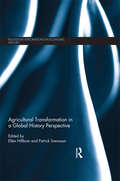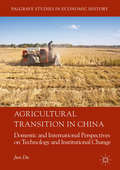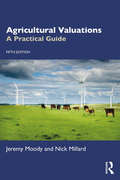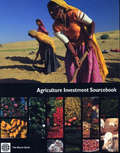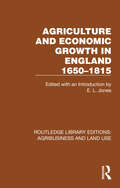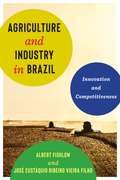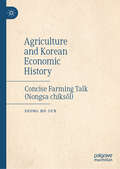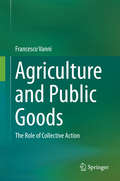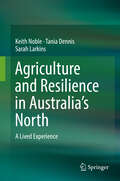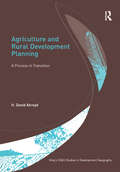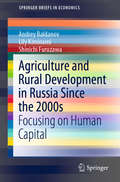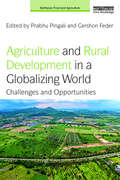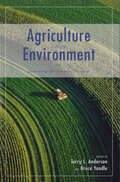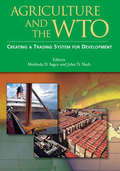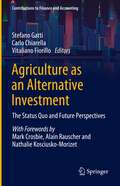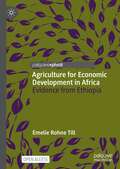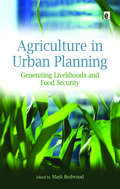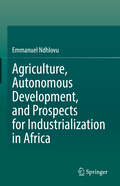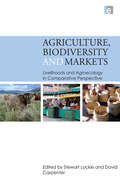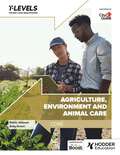- Table View
- List View
Agricultural Transformation in a Global History Perspective (Routledge Explorations in Economic History)
by Ellen Hillbom Patrick SvenssonHistory teaches us that agricultural growth and development is necessary for achieving overall better living conditions in all societies. Although this process may seem homogenous when looked at from the outside, it is full of diversity within. This book captures this diversity by presenting eleven independent case studies ranging over time and space. By comparing outcomes, attempts are made to draw general conclusion and lessons about the agricultural transformation process.
Agricultural Transition in China: Domestic And International Perspectives On Technology And Institutional Change (Palgrave Studies In Economic History)
by Jun DuDeepens readers’ understanding of the nature of contemporary Chinese economic development .<P><P> Relaxes the hypothesis of the perfect market condition to discuss institutional and technological changes in Chinese post-reform agriculture under the complex market institution.<P> Highlights the decisive role of market institutions in determining the selection and transition of agricultural technologies.<P> This book extends current research on the political economy of modern China, with particular regard to agricultural development and its role in economic transition. It uses Neoclassical principles to re-interpret agricultural growth and technological change under complex market institutions with empirical studies on China and selected East Asian economies. The text also questions how technological advances in China contribute to the Great Divergence debate.<P> Through a comparative analysis of agricultural technical changes in the planting of rice paddies in Japan, Taiwan and China, Du finds that different market institutions and structures have given rise to considerable diversity of agricultural change between different economies in terms of the nature, timing and duration of technological transition. Such diversification has, in turn, affected the trajectories of agricultural and wider economic growth.<P> Here, Du reflects on the nature of contemporary Chinese economic development and extends observations on agricultural transition to the entirety of Asia, finding that the nature, timing, and time-span of agriculture technology transitions have varied considerably across different economies. <P>
Agricultural Valuations: A Practical Guide
by Jeremy Moody Nick MillardAgricultural Valuations: A Practical Guide has long been the standard text for students and professionals working on agricultural valuations. Taking a practical approach, it covers all the relevant techniques and legislation necessary to correctly value farms, assess farm rents, carry out arbitrations, inventories and records of condition, including valuation clauses on sales of farms, livestock, soils, management agreements, valuation in court proceedings and a glossary of useful information. In this fifth edition, Gwyn Williams's original text is taken on by Jeremy Moody and Nick Millard, renowned experts in the field, bringing the book right up to date to reflect recent changes in the rural economy, including development, diversification and renewable energy and specialist valuations and reference to all the latest legislation. Clear and accessible to students and professionals alike, readers will find Agricultural Valuations an invaluable guide to best practice in agricultural valuations.
Agricultural Value Chains in India: Ensuring Competitiveness, Inclusiveness, Sustainability, Scalability, and Improved Finance (India Studies in Business and Economics)
by Harsh Wardhan Ashok Gulati Kavery GangulyThis open access book provides a clear holistic conceptual framework of CISS-F (competitiveness, inclusiveness, sustainability, scalability and access to finance) to analyse the efficiency of value chains of high value agricultural commodities in India. It is based on the understanding that agriculture is an integrated system that connects farming with logistics, processing and marketing. Farmer’s welfare being central to any agricultural policy makes it very pertinent to study how a value chain works and can be strengthened further to realize this policy goal. This book adds value to the existing research by studying the value chains end-to-end across a wide spectrum of agricultural commodities with the holistic lens of CISS-F. It is not enough that a value chain is competitive but not inclusive or it is competitive and inclusive but not sustainable. The issue of scalability is very critical to achieve macro gains in terms of greater farmer outreach and sectoral growth. The research undertaken here brings out some very useful insights for policymaking in terms of what needs to be done better to steer the agricultural value chains towards being more competitive, inclusive, sustainable and scalable. The value chain specific research findings help draw very nuanced policy recommendations as well as present a big picture of the future direction of policy making in agriculture.
Agriculture Investment Sourcebook
by World BankInvesting to promote agricultural growth and poverty reduction is a central pillar of the World Bank's current rural strategy, 'Reaching the Rural Poor' (2003). This 'Sourcebook' addresses how to implement the rural strategy, by sharing information on investment options and identifying innovative approaches that will aid the design of future lending programs for agriculture. It provides generic good practices and many examples that demonstrate investment in agriculture can provide rewarding and sustainable returns to development efforts. It is divided into eleven self-contained modules. Each module contains three different types of subunits that can also be stand-alone documents: I. Module Overview II. Agricultural Investment Notes III. Innovative Activity Profiles. The stand-alone nature of the subunits allows flexibility and adaptability of the material. Selected readings and web links are also provided for readers who seek more in-depth information. The 'Sourcebook' draws on a wide range of experiences from donor agencies, governments, institutions, and other groups active in agricultural development. It is an invaluable reference tool for policy makers, professionals, academics and students, and anyone with an interest in agricultural investments.
Agriculture and Economic Development in Europe Since 1870 (Routledge Explorations in Economic History)
by Pedro Lains Vicente PinillaWhilst many books on the European economy have focused on the analysis of its industrial sectors, this book draws attention to the often ignored contribution made by the development of European agriculture over the past two centuries. In doing so, the authors adopt a revisionist perspective on the subject, addressing the lack of coherent study of the agricultural sector and reassessing old theories about the links between agricultural and economic development. In focusing on those countries which by 1870 still had a large agricultural sector, namely, France, Germany, Italy, Denmark, The Netherlands, Sweden, Spain, Portugal, Poland, Hungary, Greece and Turkey, this book determines the role of the agricultural sector in the economic development of Europe. These chapters demonstrate how the rate of development in the agricultural sector depended on specific industrial, political and market conditions; the diversity of ways and timings through which transformation was achieved is also considered.
Agriculture and Economic Growth in England 1650-1815 (Routledge Library Editions: Agribusiness and Land Use #15)
by E. L. JonesOriginally published in 1967, this was the first book to discuss why agricultural supply became more ‘responsive’ and to provide broadly based evidence of the ways in which that ‘responsiveness’ may have influenced the growth of the economy. The editor chose 7 essays, reprinted in full, to illustrate altered perspectives of agricultural change. His substantial introduction places the beginnings of a significant rise in farm output as far back as the mid-seventeenth century and concludes that agriculture played a vital but complicated role in the economy of eighteenth-century England.
Agriculture and Industry in Brazil: Innovation and Competitiveness
by Albert Fishlow José Eustáquio Vieira FilhoAgriculture and Industry in Brazil is a study of the economics of Brazilian agriculture and industry, with a special focus on the importance of innovation to productivity growth. Albert Fishlow and José Eustáquio Ribeiro Vieira Filho examine technological change in Brazil, highlighting the role of public policy in building institutions and creating an innovation-oriented environment.Fishlow and Vieira Filho tackle the theme of innovation from various angles. They contrast the relationship between state involvement and the private sector in key parts of the Brazilian economy and compare agricultural expansion with growth in the oil and aviation sectors. Fishlow and Vieira Filho argue that modern agriculture is a knowledge-intensive industry and its success in Brazil stems from public institution building. They demonstrate how research has played a key role in productivity growth, showing how prudent innovation policies can leverage knowledge not only within a particular company but also across whole sectors of the economy. The book discusses whether and how Brazil can serve as a model for other middle-income countries eager to achieve higher growth and a more egalitarian distribution of income. An important contribution to comparative, international, and development economics, Agriculture and Industry in Brazil shows how the public success in agriculture became a prototype for advance elsewhere.
Agriculture and Korean Economic History: Concise Farming Talk (Nongsa chiksǒl)
by Seong Ho JunThis book is an economic history of the Chosŏn dynasty (1392-1910). The Chosŏn dynasty is not only known for managing the northeastern regions of Asia for 500 years as the exemplars of Confucianism, their kingdom was also one of the greatest so-called “agricultural states under Heaven.” The Chosŏn dynasty has been briefly explored academically by Western scholars, but their findings have some limitations. The period of 1400-1600, in particular, has been too poorly reported on in the English language to gain the attention of the Western knowledge society. This book aims to fill the gaps in the existing research and will be of interest to economists, scholars of Korean history, agriculturists, and ecologists.
Agriculture and Public Goods: The Role of Collective Action
by Francesco VanniThe debate on the future orientation of the EU Common Agricultural Policy (CAP) is increasingly shaped by the role of agriculture in providing public goods, and there is a broad consensus that this approach will be particularly relevant in legitimating the policy intervention in agriculture in the future. In the context of this debate, it is not clear to what extent collective action could be taken into consideration as a valuable alternative to market or state regulation in contributing to the provision of public goods, and to what extent it is possible to design and implement agricultural policies that incorporate a collective and collaborative approach between different stakeholders in rural areas. Through an in depth analysis two case studies in Italy, the book provides insights to both the policy and the theoretical debate on the role of collective action for the public goods associated to agriculture.
Agriculture and Resilience in Australia’s North: A Lived Experience
by Keith Noble Tania Dennis Sarah LarkinsThis book examines the mechanisms and strategies farmers in North Australia adopt to manage the setbacks and challenges they face. This social research is based on farmers’ experiences, but also draws on the author’s own experience after his tropical fruit farm was destroyed by two Category 5 cyclones in five years.Through historical analysis, the book compares historic and contemporary aspirations for northern development, and discusses the influence of the built environment on individuals as well as access to health and other social services.Exploring the implications of individual resilience strategies for policy development within the broader context of northern development and evolving environmental governance, the book also highlights the fact that this is occurring in a new geological epoch – the Anthropocene.The book will provide a unique perspective and understanding to government, individuals and industries interested in northern Australia and its relationship to the world
Agriculture and Rural Development Planning: A Process in Transition (King's SOAS Studies in Development Geography)
by H. David AkroydThis book meets the needs of teachers and students of agriculture and rural development project and programme planning, planners employed by governments in developing countries and by external financing agencies. Project planners must understand the aspirations of rural families and their local leaders, the national development and sector planning goals and policies of their governments and the development goals and policy priorities perceived by external financing agencies in relation to their countries. These areas are not always consistent and trade-offs may be required. However it is recognised that poor project planning is a major constraint to the sustainable realization of project and programme objectives and sector goals. Illustrated with case studies and logical framework matrices, this book presents well-established and relatively new practices followed in the context of agriculture and rural development project and programme planning. Although based on experiences gained in Africa, the issues described are relevant to planning problems encountered in other developing regions of the world. It addresses the main factors which affect the success of planning such as a government's ability to guarantee macro-economic stability and sound sector development policies; the shift from 'top-down', bureaucratic to 'bottom-up', participatory planning approaches and the roles played by external financing agencies. It explains key technical, financial, economic, environmental, socio-cultural, equity, gender and institutional-strengthening issues concerning planning in rural areas and reviews the planning tools and approaches available. The procurement of goods and services, the disbursement of funds and monitoring and evaluation requirements are examined in detail.
Agriculture and Rural Development in Russia Since the 2000s: Focusing on Human Capital (SpringerBriefs in Economics)
by Lily Kiminami Andrey Baldanov Shinichi FuruzawaThis book clarifies the status quo and mechanisms of agricultural and rural development in today’s Russia, especially focusing on human capital and human development. It provides readers insights into agricultural and rural development from the perspectives of agricultural economics, developmental economics, and regional–spatial science. Further, it addresses key research questions such as whether agricultural development in Russia has made significant strides, whether it has improved the nation’s food security and rural development, and whether structural changes in the agricultural sector as well as human capital have had impacts on agricultural development since the 2000s. In terms of analytical methods, structural equation modeling and stochastic frontier analysis are employed to capture the relationship between agriculture and rural development in regional Russia. In closing, policy challenges are identified to promote social innovation for rural development by enhancing the human capital of rural youth, including entrepreneurship. Given its scope, the book is highly recommended for all readers seeking an in-depth and up-to-date overview of agricultural and rural development in contemporary Russia.
Agriculture and Rural Development in a Globalizing World: Challenges and Opportunities (Earthscan Food and Agriculture)
by Prabhu Pingali; Gershon FederRapid structural transformation and urbanization are transforming agriculture and food production in rural areas across the world. This textbook provides a comprehensive review and assessment of the multi-faceted nature of agriculture and rural development, particularly in the developing world, where the greatest challenges occur. It is designed around five thematic parts: Agricultural Intensification and Technical Change; Political Economy of Agricultural Policies; Community and Rural Institutions; Agriculture, Nutrition, and Health; and Future Relevance of International Institutions. Each chapter presents a detailed but accessible review of the literature on the specific topic and discusses the frontiers in research and institutional changes needed as societies adapt to the transformation processes. All authors are eminent scholars with international reputations, who have been actively engaged in the contemporary debates around agricultural development and rural transformation.
Agriculture and the Environment: Searching for Greener Pastures
by Terry L. Anderson Bruce YandleAlthough US agriculture is the envy of the world, there is a growing gap between what is and what could be produced. The gap is due in part to a growing morass of environmental regulations, which limit US food production without necessarily improving environmental quality. In this compilation, leading experts examine a range of questions posed by these constraints and offer ideas for reform.Authors explore whether we are really running out of prime farmland; how best to preserve environmentally sensitive land, and for how long; whether controls on agricultural land use can prevent urban sprawl; whether chemicals that contribute to agricultural productivity are harmful to the environment; the connections between genetically modified crops and human health; how taxes affect land use; what role water markets play in balancing agricultural productivity and wildlife habitat; and the effects of the Endangered Species Act on land use.
Agriculture and the Great Depression: The Rural Crisis of the 1930s in Europe and the Americas (Perspectives in Economic and Social History)
by Gérard Béaur Francesco ChiapparinoWhat role did the agricultural sector play in the economic crash of 1929? Taking evidence from country cases across Europe and the Americas, this edited volume explores short-, medium- and long-term perspectives on the primary sector. The monograph brings together the voices of an international panel of contributors who examine issues such as falling prices, industrial production, unemployment and the stagnation of aggregate demand. Together, they frame the interwar period as a pivotal turning point in the decline of subsistence agriculture and the growth of agricultural subsidies, which remain a key policy tool in many economies today. This illuminating book will be of interest to advanced students and researchers in economic history, agricultural history, globalization, and economic development.
Agriculture and the New Trade Agenda
by L. Alan Winters Merlinda D. IngcoThis collection of essays provides the definitive survey of the importance of agricultural reform to the future of the world's trading system. There is growing consensus concerning the need to reduce the level of subsidies in agriculture and to open up the markets of the developed world more to the farmers of the developing world. However, while non-governmental organizations such as Oxfam may agree on this point with free trade economists, governments in Europe and the U. S. seem reluctant to give up their protectionist habits.
Agriculture and the WTO
by John D. Nash Merlinda IngcoDeveloping countries have a major stake in the outcome of trade negotiations conducted under the auspices of the World Trade Organization (WTO). 'Agriculture and the WTO: Creating a Trading System for Development' explores the key issues and options in agricultural trade liberalization from the perspective of these developing countries. Leading experts in trade and agriculture from both developed and developing countries provide key research findings and policy analyses on a range of issues that includes market access, domestic support, export competition, quota administration methods, food security, biotechnology, intellectual property rights, and agricultural trade under the Uruguay Round Agreement on Agriculture. Material is covered in summary and in comprehensive detail with supporting data, a substantial bibliography, and listings of online resources. This book will be of interest to policymakers and analysts in the fields of development economics and commodities pricing and trade.
Agriculture as an Alternative Investment: The Status Quo and Future Perspectives (Contributions to Finance and Accounting)
by Stefano Gatti Carlo Chiarella Vitaliano FiorilloUnder the pressure of climate and social changes, agriculture is called to play a fundamental role in the world food challenge of the next few decades. A severe reduction of arable land and water scarcity combined with a growing food demand, changes in the dietary preferences in many countries and, more recently, a growing threat to food security and logistics from supply chains interruptions and global trade fragmentation, all require the implementation of processes, techniques, and innovations able to increase productivity and make a better use of scarce resources.Against this backdrop, a growing number of investors and asset managers have started looking at agriculture as an interesting investment theme to exploit the long-term strategic opportunities emerging from technological innovation and social changes. The industry is undergoing a process of transformation driven, on the one hand, by the emergence of new data and technologies that promise enhancing process efficiency and improve yields and, on the other hand, by an increased attention on the GHG emissions of agricultural processes and the impact of farmland on climate change, water and land scarcity. All these factors call for a radical rethinking of many agriculture business models. This book provides a detailed overview and analysis of those new technologies with the greatest potential to disrupt agriculture products and processes by improving productivity and the management of food loss and waste, making a more efficient and sustainable use of resources and enhancing food security. Then, it discusses the implications for investors and asset managers, starting with an assessment of the status quo of agriculture investing and providing a thorough description of the agriculture asset class with an emphasis on its distinctive characteristics and the innovations in the technological processes used in agriculture and farming with the greatest potential to obtain long-term sustainable returns.
Agriculture for Economic Development in Africa: Evidence from Ethiopia
by Emelie Rohne TillThis book explores the role of agriculture in long-term economic growth. With a particular focus on Ethiopia, the role of the state in igniting agricultural growth and in sustaining economic growth is highlighted as essential for low-income countries. Taking ideas from both economic history and development economics, the ability of Ethiopia and the rest of Africa to sustain recent rapid growth into something that can tackle the development agenda is discussed, alongside policy suggestions.This book overall presents an optimistic account of Africa and its economic prospects. It will be relevant to students and researchers interested in economic development and agricultural economics.This is an open access book.
Agriculture in Urban Planning: Generating Livelihoods and Food Security
by Mark RedwoodThis volume, by graduate researchers working in urban agriculture, examines concrete strategies to integrate city farming into the urban landscape. Drawing on original field work in cities across the rapidly urbanizing global south, the book examines the contribution of urban agriculture and city farming to livelihoods and food security. Case studies cover food production diversification for robust and secure food provision; the socio-economic and agronomic aspects of urban composting; urban agriculture as a viable livelihood strategy; strategies for integrating city farming into urban landscapes; and the complex social-ecological networks of urban agriculture. Other case studies look at public health aspects including the impact of pesticides, micro-biological risks, pollution and water contamination on food production and people. Ultimately the book calls on city farmers, politicians, environmentalists and regulatory bodies to work together to improve the long term sustainability of urban farming as a major, secure source of food and employment for urban populations. Published with IDRC
Agriculture, Autonomous Development, and Prospects for Industrialization in Africa
by Emmanuel NdhlovuThe book investigates the intersection of agriculture and development in Africa and how it impacts rural industrialisation prospects. It provides a comprehensive view of the position of agriculture in African socio-economic activities and the agricultural sector's potential as the source for continental development and industrialisation prospects. Significant research has been done on African development with a focus placed on the problematic role played by slavery, colonialism and later by incompetent African leaders who failed to steer development of the type that delivers a progressive, sustained and sustainable transformation of lives and societies. There is limited focus on the possibility of agriculture being the potential basis of African development and the chance for industrialisation. This is a matter of concern, considering the dominance of agriculture as a livelihood and income source for many people on the continent. In contributing to the debate on development in Africa, this book aims to show how agriculture can serve as the basis for African development and industrialisation. This will be achieved by (i) providing a detailed historical description of the position of agriculture in African socio-economic activities, (ii) outlining the trajectory of African development with a focus on agriculture, innovation, and mechanisation, (iii) identifying challenges to the development of African agriculture, (iv) exploring the opportunities for agricultural development in Africa, and (v) providing practical and policy recommendations to improve African agriculture and make it the engine for development and industrialisation. Utilising a multidisciplinary approach which combines political economy, social policy, financial inclusion, and empowerment approaches, the book also shows how engagement of youth and women, digitalisation, and the provision of support (by public and private actors) can jump-start agriculture as the engine of African development and industrialisation. Taken together with this conscious effort to promote a multi-disciplinary discussion, the book is valuable reading for students, policymakers, and activists interested in emerging new directions in African development thinking and research.
Agriculture, Biodiversity and Markets: Livelihoods and Agroecology in Comparative Perspective
by Stewart Lockie David CarpenterDebate about how best to ensure the preservation of agricultural biodiversity is caught in a counter-productive polemic between proponents and critics of market-based instruments and agricultural modernisation. This book argues that neither position does justice to the range of strategies that farmers use to manage agrobiodiversity and other livelihood assets as they adapt to changing social, economic, and environmental circumstances. Chapters explore relationships between the exploitation and conservation of agricultural biodiversity and the livelihoods of agricultural communities, and evaluate the capacity of national and multilateral institutions and policy settings to support the protection and capture by communities of agrobiodiversity values. The place of ecosystem services in valuing biodiversity in the marketplace is emphasized. A number of authors assess the potential for market-based instruments and initiatives to encourage the protection of biodiversity, while others compare agrobiodiversity/community relationships, and the effectiveness of instruments designed to enhance these, across international boundaries. The book takes a comparative approach, drawing on empirical case studies from across the developed and developing worlds. In doing so, the book does not simply point to similarities and differences in the experience of rural communities. It also shows how global trade and multilateral institutions bring these otherwise disparate communities together in networks that exploit and/or preserve agrobiodiversity and other resources.
Agriculture, Environment and Animal Care T Level: Core
by Sally Green Robin JacksonGrow your knowledge, understanding and skills as you begin your path to a career in Agriculture, Environment and Animal Care.Created in association with City & Guilds and written by experienced practitioners Robin Jackson and Sally Green, this accessible T Level textbook provides comprehensive coverage of the core content, guiding you through the key topics, terminology and practices included in the qualification.- Build your knowledge of the core T Level content, including challenging topics such as business, finance, sustainability and ethics, plus content for several core pathways- Stay on track throughout the course, using the learning objectives at the start of each chapter and the 'Test Yourself' questions throughout- Improve your understanding of industry terminology with key terms defined clearly throughout- Develop a deeper understanding of each topic with case studies and varied activities, which help to contextualise the content within the industry- Feel confident ahead of assessment with practice questions to consolidate your knowledge and providing opportunities to test your skills
Agriculture, Environment and Animal Care T Level: Core
by Sally Green Robin JacksonGrow your knowledge, understanding and skills as you begin your path to a career in Agriculture, Environment and Animal Care.Created in association with City & Guilds and written by experienced practitioners Robin Jackson and Sally Green, this accessible T Level textbook provides comprehensive coverage of the core content, guiding you through the key topics, terminology and practices included in the qualification.- Build your knowledge of the core T Level content, including challenging topics such as business, finance, sustainability and ethics, plus content for several core pathways- Stay on track throughout the course, using the learning objectives at the start of each chapter and the 'Test Yourself' questions throughout- Improve your understanding of industry terminology with key terms defined clearly throughout- Develop a deeper understanding of each topic with case studies and varied activities, which help to contextualise the content within the industry- Feel confident ahead of assessment with practice questions to consolidate your knowledge and providing opportunities to test your skills
